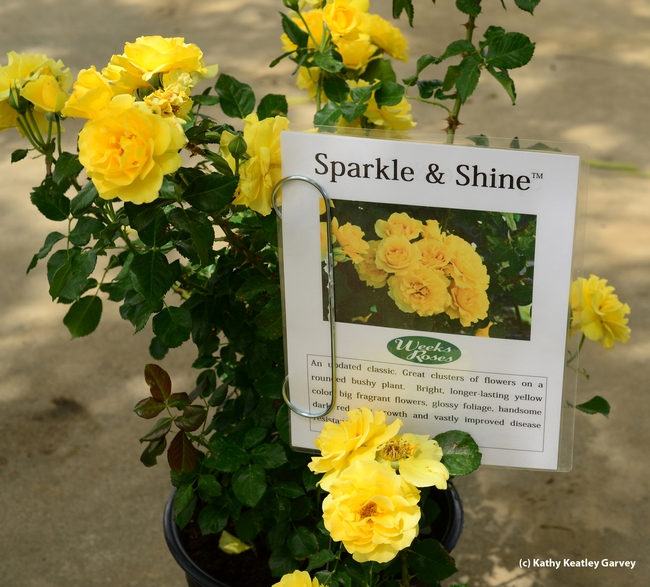- Author: Kathy Keatley Garvey
It won't bloom until summer, but already many eyes are on the California buckeye.
The tree's blossoms are poisonous to honey bees. Bees are attracted to them and forage on them, but the end result of the food provisions to the colony can be deformed larval development.
We've seen bee hives within a quarter of a mile of California buckeyes (Aesculus californica). And we've seen honey bees, native bees and other pollinators foraging on the blossoms.
At the recent UC Davis Pollinator Gardening Workshop hosted by the California Center for Urban Horticulture, Extension apiculturist Eric Mussen talked about the poisonous plants. (See PowerPoint presentations.) That led to one workshop participant wondering if the flowers of the California buckeye are poisonous to native bees. (Honey bees are not native; the European colonists brought them to the Jamestown colony, Virginia, in 1622).
Responded Mussen: "My guess: either the native bees that have been in the areas around California buckeye for a long, long time are not poisoned by the pollen or they have been selected (by death of the other genetic types) to avoid the pollen, that eons of natural selection have adapted them to coexist with California buckeye while using their resources."
Native pollinator specialist Robbin Thorp, emeritus professor of entomology at UC Davis, shared: "We know California buckeye nectar and/or pollen is toxic to honey bees from years of experience with managed hives. Toxicity to native bees and other flower visitors is not so easily determined and to my knowledge has not been investigated. The fact that populations of native bees and butterflies visit California buckeye flowers and continue to persist in areas where the tree is a dominant part of the plant community tends to confirm what Extension apiculturist Eric Mussen says about them. Some good research projects here. So we still do not know if it is the nectar, pollen, or both that may be toxic to honey bees, much less to native flower visitors."
According to gardeningguides.com, the seeds in their raw state are poisonous to humans, but native Americans learned to get around that and use them for food. They pounded the seeds into flour and then cooked the mixture. "This tree had multiple cultural uses among California Indian tribes," the website says. "Many indigenous groups utilized buckeye seeds for food, often when other plant food sources were scarce. These tribes included the Costanoan, Salinan, Kitanemuk, Serrano, Wappo, Sierra Miwok, Coast Miwok, Chumash, Kawaiisu, Northern Maidu among others. The Pomo ate the seeds even when other important food plants were plentiful. The seeds are poisonous to humans in the raw state. Thus, the nuts were cracked open with a rock, the shells removed, the seeds pounded into flour, and their toxic saponins removed in a lengthy leaching process. The meal was subsequently cooked and eaten. There are many different methods for processing and cooking buckeye seeds for food, depending upon the tribe. The seeds have medicinal properties and were cut into pieces, mixed with water, and made into suppositories for hemorrhoids by the Costanoan and Kawaiisu. The Pomo cut bark from the base of the tree and made a poultice, which was laid on a snakebite. Young buckeye shoots were sometimes used as spindles or twirling sticks in fire-making kits of the Sierra Miwok, Northern Maidu, Wappo, Yahi and other tribes. Many tribes mashed buckeye nuts and poured the contents into quiet pools to stupefy or kill fish."
And, no wildlife will eat buckeye seeds except squirrels, such as the California ground squirrel (Citellus beecheyi).
Meanwhile, the poisonous blossoms continue to beckon the honey bees--and their colonies keep producing deformed bees.

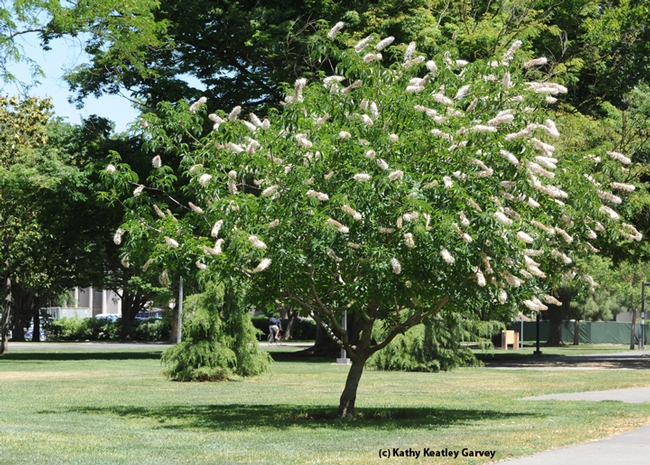
- Author: Kathy Keatley Garvey

They're there for the pollen.
"California poppies provide only pollen--no nectar," native pollinator specialist Robbin Thorp, emeritus professor of entomology at UC Davis, told the Pollinator Gardening Workshop last Saturday on the UC Davis campus. Thorp was one of the featured speakers at the event, sponsored by the California Center for Urban Horticulture.
Thorp, who identifies thousands of bees a year for researchers, enthralled the audience with facts about bees. Although he retired in 1994, he maintains an office at the Harry H. Laidlaw Jr. Honey Bee Research Facility at UC Davis, and is one of the instructors of The Bee Course.
Some of the information he presented:
- Unlike wasps, which are carnivorous, "bees are vegans." They gather pollen and nectar from plants. (They also collect water and propolis, or plant resin, for their colonies.)
- "Flowers don't have wings; so we need the pollinators to come to them."
- The global population of bees includes some 19,500 named species. Of that number, about 4000 different species of bees occur in North America; 1600 in California, and more than 300 species of bees in Yolo County. (Over the last four years, Thorp has found more than 80 species of bees in the Häagen-Dazs Honey Bee Haven a half-acre bee friendly garden on Bee Biology Road maintained by the UC Davis Department of Entomology and Nematology.)
- Seventy percent of bees are solitary, and most nest in the soil.
- Fifteen percent of bees are cuckoo bees; the females lay their eggs in other bees' nest and their offspring eat the provisions
- Only 10 percent of bees are social (honey bees are among them)
Thorp recommends that if you want to attract native bees, provide food (bee plants), water and shelter. "Leave some bare soil, avoid mulch madness, and provide bee condos (drilled blocks of wood that blue orchard bees and leafcutting bees use for their nesting sites.)
"Plant it and they will come," Thorp said. "Provide habitat and they will stay and reproduce."
Thorp is the co-author of a newly published book, "Bumble Bees of North America" (Princeton University Press) and a co-author (with Gordon Frankie of UC Berkeley and colleagues) of a pending book with the working title, "California Bees and Blooms."
One of the websites Thorp recommends is the UC Berkeley Urban Bee Lab website, http://www.helpabee.org/, which provides information on native bees, gardening for bees, and current projects and partnerships.

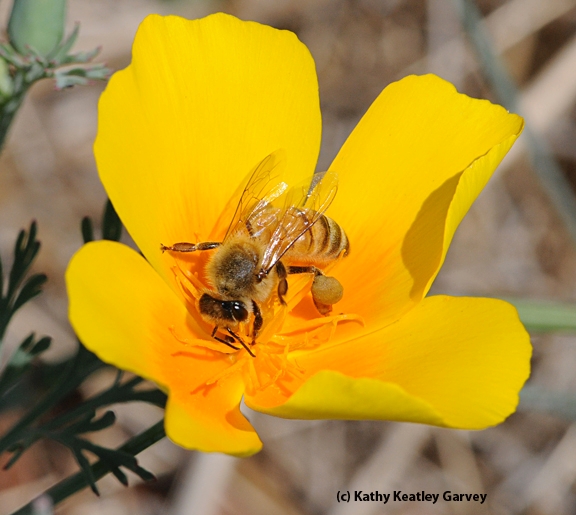
- Author: Kathy Keatley Garvey
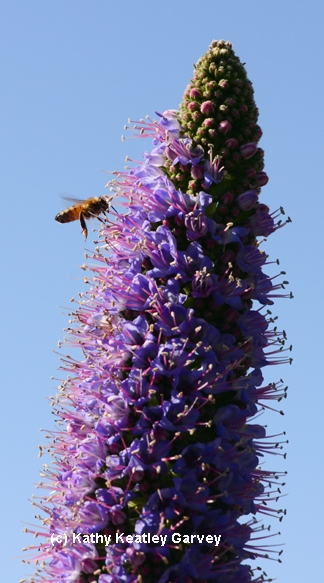
The purplish-blue spiked flowers attract honey bees, bumble bees and syrphid flies.
And visitors. And photographers.
The honey bees were buzzing all over the Echium last Sunday, Feb. 16, as were syrphid flies, aka hover flies or flower flies. But a yellow-faced bumble bee, Bombus vosnesenskii, preferred to hide beneath the leaf of a passionflower vine (Passiflora). Next time!
The towering Pride of Maderia, which can easily reach a height of six feet or more, is the pride of the Portuguese island of Madeira, where it's endemic. It's an evergreen bush planted as a drought-tolerant ornamental, particularly in coastal communities. It even gained the Royal Horticultural Society's Award of Garden Merit.
Wikipedia informs us that the genus name is derived from the Greek "echion," and that the root word "echis" means "viper." Think snake. Apparently the shape of the seed resembles that of a viper's head. Another interpretation: there's an age-old belief that another Echium species, Echium vulgare, aka "Viper's Bugloss," is a remedy for the adder's bite.
However, Echium candicans is not so popular in the state of Victoria, Australia, where it is considered "a high weed risk" and its very presence prompts the Department of Primary Industries to send in the troops...er...alerts.
The first blooms of the year in Bodega, though, are cause for celebration.
And speaking of bees and blooms, you'll want to sign up for the "Pollinator Gardening Workshop, Your Sustainable Backyard,"set Saturday, March 15 at UC Davis. Hosted by the California Center for Urban Horticulture (CCHU), it will take place at Giedt Hall, UC Davis campus, with a side trip to the Häagen-Dazs Honey Bee Garden, just west of the campus, on Bee Biology Road.
Registration is underway at on the CCHU website.
CCHU program manager Anne Schellman says that this will be an informative workshop where participants will learn:
- How to identify common bee pollinators
- How to make a landscape pollinator-friendly
- Which plants pollinators prefer
- The latest research about honey bee health and pollinator habitat
- How UC Davis helps honey bees at the Häagen-Dazs Honey Bee Garden
Honey bee and native pollinator specialists with the UC Davis Department of Entomology and Nematology will be among the speakers. (See previous Bug Squad blog.)
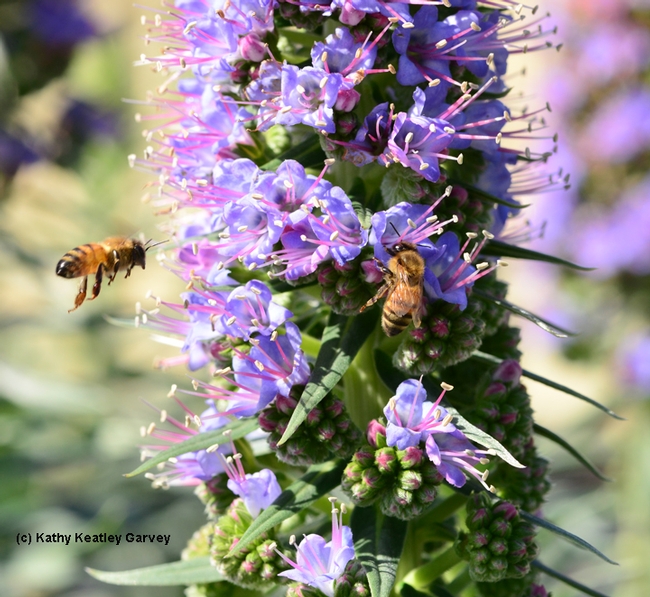

- Author: Kathy Keatley Garvey
Poet Gertrude Stein, who coined "A rose is a rose is a rose," probably would have liked it.
Julia Child, maybe not.
We purchased a "Sparkle and Shine" yellow rose, related to the Julia Child Rose, last May at the rose sale sponsored by the California Center for Urban Horticulture, University of California, Davis. It's drawing quite a bit of attention from insects in our yard.
And not just from honey bees, earwigs and spottted cucumber beetles.
From flies.
We recently spotted this drone fly (Eristalis tenax) foraging among the blossoms. Startled by the camera movement, it kept flying off, only to return within seconds.
At first glance, non-entomologists would probably identify it as a honey bee. It's a floral visitor, right?
Right. But not all floral visitors are flies, and not all pollination involves bees.
Wikipedia says that in its natural habitat, the drone fly "is more of a curiosity than a problem, and the adults are benficial pollinators."
It's the larva, the red-tailed maggot, that makes some people shudder. The larvae, as Wikipedia says, live "in drainage ditches, pools around manure piles, sewage, and similar places containing water badly polluted with organic matter."
So from a pool around a manure pile to a beautiful Sparkle and Shine yellow rose. Who would have thought?



- Author: Kathy Keatley Garvey
It's not "Rise and Shine!" any more.
It's "Sparkle and Shine."
"Sparkle and Shine," a yellow rose related to the Julia Child Rose, drew quite a bit of attention at the UC Davis event, "Roses: the "Eyeconic Weekend," sponsored May 4-5 by the California Center for Urban Horticulture (CCUH) at Foundation Plant Services, 455 Hopkins Road, west of the central campus.
Participants loved it--and so did the honey bees. The bees--probably from the nearby Harry H. Laidlaw Jr. Honey Bee Research Facility--beelined to that floribunda, but they also foraged on many other roses.
CCUH executive director Dave Fujino described the event as quite successful. The good news is that some of the roses are still available for sale. An online rose catalog depicts such roses as Yabba Dabba Doo, Big Momma, Tiddly Winks, Wild Blue Yonder, McCartney Rose, Passionate Kisses, and Oh My!
You can email Fujino at dwfujino@ucdavis.edu with your rose request (and ascertain the availability) and then purchase the roses at the Foundation Plant Services site, corner of Hopkins and Straloch roads, from 4 to 5 p.m. on Wednesday, May 8 and Friday, May 10, Fujino said. (From west Hutchison Drive, take Hopkins Road and then Straloch Road. See map.)
Then it's gearing up for next year's rose days. The event (free admission) is always held the first weekend of May, right before Mother's Day. Guests look forward to touring eight acres of roses, learning rose care at informational/training sessions, and gracing their gardens with their choices.
The bees foraging on the roses are "free" but they won't go home with you because they already have a home!

